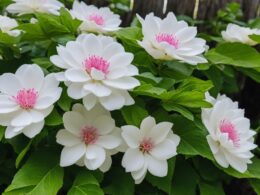Discover the beauty of tropical perennial plants with their stunning large heart-shaped leaves. Elephant ears, belonging to the arum or aroid family, are a captivating addition to any garden or landscape design. Native to tropical regions of Asia, the Pacific Islands, and tropical America, these plants have been cultivated for centuries for their edible corms or tubers, which are staple foods in these regions.
The leaves of the elephant ear plant are edible but must be cooked before consumption due to skin irritants. In their native habitat, the leaves can grow up to 3 feet long and 2 feet wide or more, creating a bold and dramatic display. While flowers are not common in the Midwest, elephant ears can bloom, showcasing typical aroid inflorescences with a spathe and spadix, and developing into globular berries.
In recent years, breeding programs have introduced numerous ornamental varieties of elephant ears, offering a diverse range of colors and leaf shapes. These tropical beauties can bring a touch of boldness and elegance to your garden, allowing you to create lush and vibrant tropical gardens.
Growing Elephant Ears
Elephant ears, with their large, heart-shaped leaves, are a stunning addition to any garden or landscape. If you’re interested in growing these tropical beauties, here are some essential tips to help you successfully cultivate them.
First, consider the planting location for your elephant ears. These plants can be grown in beds, borders, or containers. Keep in mind that as they grow, elephant ears have the potential to shade out smaller plants, so choose a location where they won’t overpower their neighbors.
To ensure optimal growth, elephant ears require lots of water and fertilizer. Make sure to water them regularly and deeply, especially during hot and dry periods. Additionally, provide them with a balanced fertilizer to promote healthy foliage and vigorous growth.
If you’re starting elephant ears from scratch, it is best to begin with a large bulb or a rooted plant. This will give you a head start and help you achieve the desired size and form for your plants.
In colder climates, it is recommended to start growing elephant ears indoors in early spring. This allows them to establish strong root systems before being exposed to outdoor conditions. Once the weather warms up, you can transplant them outside.
Elephant ears thrive in rich, moist soil. They can tolerate standing water, making them a great addition to water gardens. However, it’s important to note that they are sensitive to cold temperatures. If you live in a cooler climate, provide them with warm summer conditions to ensure optimal growth.
In summary, to successfully grow elephant ears, choose a suitable planting location, provide ample water and fertilizer, start indoors in colder climates, and offer them warm summer conditions. With proper care and attention, you’ll be rewarded with lush, tropical foliage that adds a touch of exotic beauty to your garden.
Elephant Ear Blooms
While elephant ears are primarily grown for their foliage, they have the potential to bloom when they reach maturity and receive the right growing conditions. However, flowering of elephant ear plants is not common in the Midwest.
If flowers do appear on your elephant ear plants, it is a common practice among gardeners to remove them. By removing the flowers, you can redirect the plant’s energy towards leaf production, allowing it to develop larger and more impressive foliage.
If you choose to leave the flowers on the plant, they will eventually develop into clusters of red or orange berries, adding a splash of color to your garden.
Some gardeners may choose to enjoy the flowers and wait to see if they get a repeat performance in the following season. However, it is important to note that the chances of flowering vary depending on the specific growing conditions and the variety of elephant ear plant.
Now that you know about the potential blooms and berries of elephant ear plants, let’s move on to the final section of this article, where we’ll provide a conclusion and offer some cultivation tips for growing these stunning plants.
Conclusion
Elephant ear plants, with their large, heart-shaped leaves, add a touch of exotic beauty to gardens and landscapes. Whether grown for their lush foliage or their occasional blooms, these plants create a tropical vibe that can transform any outdoor space into a lush oasis.
To successfully cultivate elephant ear plants, it is crucial to provide them with the right growing conditions. They thrive in rich, moist soil that is well-draining. Regular watering and fertilizing are essential to ensure their optimal growth. These plants also require warm summer temperatures and high humidity to thrive.
While the flowering of elephant ear plants may not be common, their vibrant foliage more than compensates for it. The large leaves create a visually stunning impact and make a bold statement in any garden. They can be used as focal points or as accent plants in lush tropical gardens.
If you want to create a lush tropical garden, consider incorporating elephant ear plants into your landscape design. With careful cultivation and proper care, these plants can thrive and bring a touch of the tropics to your outdoor space. So, follow these cultivation tips and enjoy the beauty of the elephant ear plant’s lush foliage and occasional blooms in your own garden.
What are the Care Instructions for Elephant Ear Plants to Ensure Flowering?
To ensure flowering, Elephant Ear Plants require indirect light, consistent moisture, and high humidity. Fertilize monthly during the growing season. Interestingly, gardeners often juxtapose these with plants that carry deeper meanings, such as when incorporating black dahlia flower symbolism planting into their garden design for contrast and conversation.










